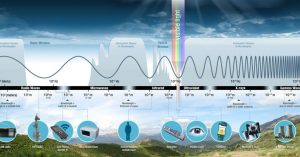
When you hear the words “cloak of invisibility” you might immediately think of items that can only be worn in movies that are of the sci-fi or magical genre. In truth, there now exists technology that can bend radio frequency ‘light’ such that an observer outside the target area cannot ‘see’ or detect the target object. If you remember, in the electromagnetic spectrum, light exists in an infinite range of frequencies.

The cloaking effect that has been discovered is for light in the radio frequency (RF) to near infrared range. In science, this is known as ‘negative refractive index’. Until recently, this effect was only observed under certain rare conditions in material science but was mainly confined to theory. In the past decade however, there has been advancement of what are called metamaterials.
Metalmaterials are micro-structured materials that exhibit electromagnetic properties not found in natural matter. In particular, composite materials created by arrays of conducting wires and split-ring resonators like the one below.

These resonators can be easily fabricated on electronic PCB with metal traces. Split-ring resonators are a very popular design that have both inductive and capacitive properties that can be seen in the previous image. Split-ring metamaterials are also called ‘left-handed metamaterials’ because of their ability to manipulate electromagnetic waves in previous unimaginable ways. There is a vast potential for future applications in optics, efficient frequency converters, power limiters, and parametric amplifiers.
It is well known that any given material’s response to electromagnetic radiation (i.e. microwaves) can be characterized by the material’s magnetic permeability and electric permittivity. The product of these two physical characteristics defines the refractive index that measures how fast the material transmits light (or electromagnetic fields) and and how light is bent on entering the material: the higher the refractive index, the slower the propagation and the stronger the deflection. Most natural materials have a positive refractive index (air or near vacuum having a refractive index = 1). Metamaterials however, can even have negative values for a refractive index. In fact, they can also be designed with a spacially varying index of refraction. This means these discrete split-ring resonators can be constructed in layers and arrays to create the desired index of refraction for a particular application. This is prerequisite for creating so-called electromagnetic ‘invisibility cloaks’ and this has already been done for microwaves!

In the illustration above, microwaves are emitted from the source and land on the layers of metamaterial that form a ring around the target object. Due to the electromagnetic properties of the metamaterial, the microwaves bend around the ring of metamaterial and the target object appears as though it is transparent to the microwaves (they do not ‘see’ the target). The illustration below shows both circular and rectangular split-ring resonator elements.

These elements are arranged in two-dimensional arrays on electronic board. These boards can then be arranged in rows to create three-dimensional structures (metamaterials). The two images below are examples of such structures.


As you can see, the elements can be created on an electronic board, making fabrication fairly simple and inexpensive. These three-dimensional structures can also be wrapped into a circular form (below) to create a 360 degree cloak for an object in the center of the form.


In a future post, we will discuss some innovations that are already in the works in addition to some ideas as to how this technology may also be of benefit to those that are targeted.
